
Our Favorite 2023 Stories As ’24 Beckons
Happy New Year’s Eve! Before we drop the ball as 2024 approaches, let’s look back at some of our favorite ASJ stories of 2023.
JANUARY: “DANCING WITH THE DEVIL” ON A SOLO SHEEP HUNT
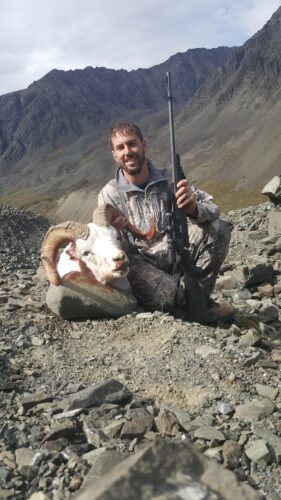
WHEN I GOT WITHIN 300 yards, one of the rams spotted me. I was caught in plain sight and my worst fears came true. The rams were ready to take off. I dropped to a shooting position and squeezed off a shot. Clear miss. My heart sank, and shock took over.
Somehow, the ram decided to run closer. He made his way towards me and set up for another broadside shot. Instinct took over and I put a bullet through his vitals. The ram was hit hard and on the move. I put two more shots through that ram and he fell to his final resting place.
I felt my heart racing and the blood pumping through my veins. I had successfully taken a Dall sheep in Alaska’s Wrangell Mountains. There I stood, a Pennsylvania boy next to a Dall sheep. You dream about these moments growing up; it’s a sort of fairy tale. You see these magnificent animals on television and you read about these badass guys hunting them in magazines. It’s real, but not reality.
I took the risk of a lifetime moving to Alaska on my own, and here I was taking another risk standing atop the most beautiful country in the world next to a full-curl ram.
I spent the next day and a half packing the sheep back to the air strip. I had danced with the devil, but it wasn’t over. I had done what I’d set out to do, but still had days until Zack was due to pick me up. The next step of my dance was about to start. -Brian Watkins
FEBRUARY: LOWER 48 FILMMAKERS ENAMORED WITH ALASKA
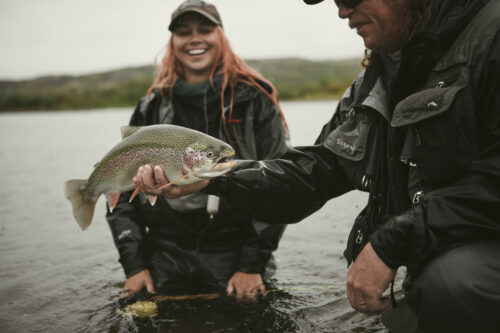
What fascinated the filmmakers was the scope of the region of Alaska they explored. Of course, they had no idea what lay ahead on the floatplane expeditions – see the waterfall that the pilot breezed over and brought the visitors back for a closer look.
But there were places even these grizzled locals were unaware of.
“Another thing that was weird, because Royal Wolf has the three planes and kind of go anywhere they want up in that region, I think there were two different times where Nate and another guide said ‘We’ve never been here.’ And I’m like, ‘You live here! This is your area!’” Walsh says. “But there are so many areas to choose from. They’d hear that the good fish were somewhere. ‘Let’s go check it out.’ And that’s what we did.”
Walsh also remembered that on one flight, the plane flew over Battle Lake, a 9-mile-long narrow body of water on the Alaska Peninsula. As the adventurous Alaskan bush pilot and plane full of anglers often do, someone suggested they land on that remote lake and check it out from the water.
“Again, it was a case of, ‘Do you want to land in that?’ ‘Sure.’ And you just do it. So that was weird. And it was so blue it seemed like we were standing in a bottle of Windex,” Walsh says.For Kresge, one of his regrets was not taking up an offer to man one of the fishing rods and pull in one of the many rainbows that succumbed to the flies at the end of the lines. But being there strictly to work and record every critical moment on film, the angling temptation was trumped by potentially missing the money shot.
“I had a camera (version of) FOMO of missing out on one moment. We kept the cameras in our hands at all times. Who knows if you’re downstream fishing and someone else gets the biggest fish of the week? It’s hard. It got offered to us a dozen times,” Kresge says. “And it’s not like we weren’t willing. We wanted to show what the experience is and if the best part of the week doesn’t get captured because we’re playing, I’d never stop thinking about that.” -Chris Cocoles
MARCH: RESTORING EKLUTNA RIVER SALMON RUNS

TO ILLUSTRATE THE CHALLENGES Eklutna salmon face, as well as demonstrate the commitment of the coalition working to bring salmon back, the CEO of Eklutna Inc., Eklutna Inc. board members, Native Village of Eklutna tribal leaders and other volunteers walked, ran and biked two salmon from Native Village of Eklutna to Eklutna Lake, nearly 11 miles up a winding mountain road.
The arriving salmon were met with the support of more than 100 community members who walked the final leg of the relay and lined up to pass the salmon one-by-one, person-by-person, up and over the dam and into Eklutna Lake where salmon belong.
“This area has been used by our people for well over 1,000 years. It is our hope that one day, within my lifetime, we will see all five species of salmon make it from saltwater up here to the lake,” Native Village of Eklutna president Aaron Leggett stated during a speech at the Return the Salmon relay.
It’s clear the Eklutna River, and the wild salmon attempting to swim home, need water and a way to swim past the
remaining dam. Alaskans have made it clear they expect the utilities to uphold their end of the bargain. Anything less will fail to meet moral and legal obligations.
In September 2022, Anchorage leaders echoed resolutions of support previously passed by the Native Village of Eklutna and the Alaska Federation of Natives. The Anchorage Assembly passed a resolution that commits their support for providing instream flow and fish passage, and requests that utility operators commit as well. This resolution passed with sweeping bipartisan approval.
Still, at the time this piece was being written, the Municipality of Anchorage, Chugach Electric Association and Matanuska Electric Association continue to drag their feet and remain unclear about their commitment to restoring the river and its salmon. Ideas such as piping water miles downstream before releasing it into the dry channel, “trapping” returning salmon downstream of the dry river and trucking them around the dam, and other inadequate proposals from the utilities would barely be Band-Aids compared to more meaningful solutions, such as allowing a fraction of the available water to flow naturally and bypass channels around the dam that have proven effective elsewhere and deserve study here. -Eric Booton
APRIL: EIGHT TRAITS FOR A PERFECT FISHING PARTNER

Fishermen will meet countless potential partners, but only a small percentage will ever make the cut. Lifelong fishing buddies will develop a special bond that is impossible to manufacture. It must come naturally.
There are certain traits that are needed for the partnership to succeed. You can have two great people who are top-notch anglers, but if their fishing personalities don’t quite mesh, then the partnership will eventually fail. I have learned what to look for in a good partner, so I am careful about who I invite to the fishing grounds.
Actually, there has only been one man who I have been fishing with that I didn’t get a vote in the matter. He was assigned to me when we met in the hospital over half a century ago. I’m talking about my father, Bob Ensalaco.
I was fortunate that my dad possesses all the characteristics of the perfect fishing partner. That’s a good thing, because it would have been awkward if I had to cut him loose after living under his roof for so long.
The rest of my inner circle came from trial and error. Some became my go-to guys because they have most of the qualities that I value, and they are the first ones I call when I have the urge to hit the river. If they’re unavailable, then I might consider inviting a handful of B-listers that I will occasionally fish with out of necessity when my regular pals are unavailable. Out of that stable, there
are only a select few who I would ever consider inviting up north. Alaska is on most anglers’ bucket list, but I’m also aware that the rigors of traveling and the hard-nosed fishing that I do isn’t for everyone. These are some of the things that I consider and steer clear from when extending an invitation to join me on one of my Alaskan excursions. -Tony Ensalaco
MAY: PADDLING THE CROSS-ADMIRALTY CANOE ROUTE
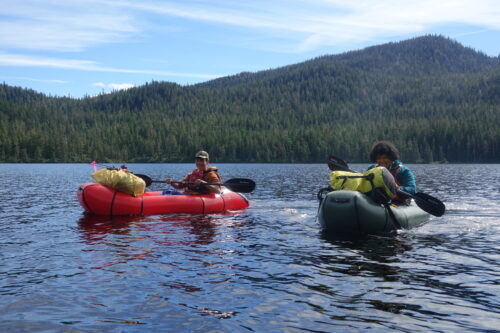
DAY 2: DAVIDSON LAKE TO HASSELBORG LAKE
There’s no way not to feel lucky when you find yourself in the woods and on the water for three warm, dry, bluebird days in Southeast Alaska. As we blew up our packrafts and paddled into the sunshine on Davidson Lake that first morning, it almost felt like the island was welcoming us.Pale green lichen hung down from the trees. A deer emerged from the brush and darted back into the forest. Sam immediately dug a piece of flagging from his pack and began imitating a deer call, trying to call it back.
We drank the muskeg “tea water” we’d gathered the day before and stopped for a delicious meal of crackers and coho salmon Beebuks’ uncle had caught in Yakutat and his family smoked and jarred in Angoon.
As we neared the end of the lake, a loon chortled across the water. Marsh grass waved in the breeze as we paddled through the lilypad-dotted slough leading from Davidson Lake to Lake Guerin. Big bull pines, their roots in muskegs, dotted the shore.
The interior of Admiralty Island is a ridge of mountains, and at Lake Guerin our surroundings began to grow higher.
We paddled past mountains with green alpine. Sam, Beebuks and Trevor, all of whom grew up hunting and had already gone out in search of deer to fill the freezer that year, speculated about where the deer might be.
At the end of Lake Guerin, we pulled up to a grassy, lilypad-lined bank and walked the one-and-a-half-mile portage, through patches of devil’s club. As we descended a small hill to the three-sided shelter at Hasselborg Lake, Sam was playing Ice Cube’s “It Was a Good Day.”
That night, Trevor, Beebuks and Sam made a fire by the side of the lake, then took out the cabin’s rowboat to fish at the mouth of the creek. Reaching the lake before it got dark and getting to go fishing for cutthroats would be one of the boys’ favorite points of the trip. -Mary Catharine Martin
JUNE: ALASKA FISHING ADVENTURES ‘ON THE FLY’
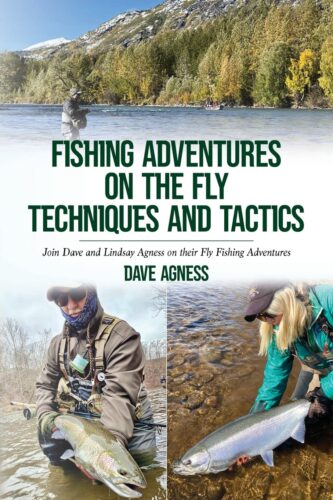
ON SUNDAY MORNING, UNDER a foggy, cloudy sky, we headed out after a hearty breakfast. As mentioned in past stories, the ride down through Turnagain Arm on the Sterling Highway is a day adventure in and of itself. We pulled over to watch beluga whales hunting along the shallow bars at low tide. Eagles soared overhead, against a snow-capped mountain range.
What we hadn’t planned for was the 4 inches of snow in the area two days before, with morning temps hovering just under freezing. As we crossed the first bridge over a small river, the SUV started sliding sideways, and as I got control we realized that as we climbed up into the mountains the roadway and bridges would be pure ice. I pulled over and locked the truck into four-by-four and proceeded cautiously.
The ride going only half-to three-quarters the speed limit took us an extra 45 minutes to an hour, but we finally arrived at our first spot, Ptarmigan Creek. The creek was low, but a more important factor was the sockeye salmon run was over, and only a few old zombies remained. We geared up, but after fishing for less than a half hour, knew the rainbows and char that would otherwise be congregating behind the salmon had moved on up to the lake for the winter.
Our next play was to run down to the Russian River, where we expected the same fate of the sockeye run, but there is a manmade walkway all the way down to the confluence of the Russian and Kenai Rivers. Now, we’ve had a few encounters with brown bears along the Russian, and if the salmon were gone, the bears would be turning to berries and other forms of nutrition. Not that I think bears intentionally seek to eat human flesh; I think they attack to maul simply because we are a nuisance and in their way.
We stopped at the Troutfitters fly shop to pick up a couple things. I asked the guy handling the counter how the bears were along the Russian, and he simply said, “They’re there!” He happened to have a spare can of bear spray and loaned it to me. I promised to bring it back before closing, and in my thoughts I hoped that would be the case.
We geared up in the lowest parking lot, “Grayling,” and jumped on the metal walkway down to the Kenai. Halfway down, sure enough, there was a pile of fresh bear scat loaded with berries on the walkway. We had been “hey bear”-ing all the way down and stopped to scan the area to make sure Mr. Bear had moved on, and found our way to the main river.
The Kenai runs pretty strong, but we found good footing and in a short while each of us hooked a couple leopard ’bows. There was a sizable island just below us, with a hard frothy run that slowed to a beautiful tailout below. Lindsay waded over and climbed up on the island. I did as well and we found a small path to the front of the island. We stopped to get our bearings and I noticed we were in a giant berry patch. In 10 more steps we came across a huge fresh pile of scat covered in berries. The tailout was 50 yards through thick brush on a game trail – meaning a bear trail. I said, ”OK, we are out of here.” -Dave Agness (excerpt from his book, Fishing Adventures on the Fly with Dave and Lindsay Agness)
JULY: EPIC EGEGIK FISHING ADVENTURES
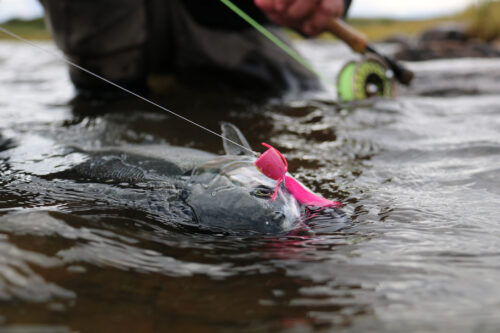
The Egegik is about the best I’ve seen when it comes to catching coho on surface poppers and plugs. Pink poppers – whether fished on a spinning or fly rod – are the ticket. I also like casting 3.0 and 3.5 Mag Lips from shore, with cerise colors dominating the lineup.
Toss a braided-line cutter into your bag, along with long-nosed pliers, and you’re set. What you’ll likely find is, even though the lodge has guides to help you on the river, you’ll be walking the banks in search of fish on your own. When this happens, you want to be able to rerig your own rods and unhook your own fish so that you’re not waiting around for help.
AN EPIC FISHING EXPERIENCE
The Egegik River is easy to wade and fish. You’ll get dropped off at daylight by a lodge boat and fish the prime holes, which can change from year to year, even day to day, based on water flow. The Egegik is a shallow river, so even high winds can move fish around.
This marks my 33rd year of fishing in Alaska. The first time I went I thought it was going to be a once-in-a-lifetime deal.
It wasn’t. Alaska grips you and keeps bringing you back, and the people at Becharof Lodge are simply wonderful to be with. Plus, you’ll never go hungry. I’ll be back again next month, and maybe I’ll see you there. -Scott Haugen
AUGUST: DREAM TRIP FOR JUNEAU KINGS

We saw a few fish roll in front of us and I had one nice king chase my Flying C to the end of the rod. Overall, we were not disappointed, as the goal of this trip was to land an Alaskan king while casting flies or lures into the salt; we weren’t expecting a full-on bloodbath of daily limits. Still, the forecast for the coming days was calling for bright sun and warm temperatures, not ideal conditions for a hot Chinook bite.
The next morning started early, as we had a falling tide and small windows to find a biting fish. Our plan was to cover water – jump in, cast for a half hour, then move on to the next spot.
Our first three stops came up empty, so we hit an area I had fished years earlier on a coho trip. The north side of Gastineau Channel is a giant sand flat until it widens out near the DIPAC hatchery, which makes for skittish fish that have just blasted in from a few hundred feet of water in Fritz Cove to just 5 or 6 feet of water in the channel. The water was high but receding, so we had a bit of a challenge to navigate our way out to a little island that had a divot off the main channel; in years past, it has held coho.
Once we settled in, my Arctic Spinner was savagely attacked by a blue-backed king within a matter of minutes. It had been a while since I had hooked a king in the Great Lakes, and the way this fish fought was on another level. Massive, angry, headshakes were followed by line-stripping runs; it was an intense encounter. Once the fish finally settled down, I was able to slide her up on a little beach that was showing at the bottom of the island we were on. Hunter assisted with the landing process, high fives ensued, and I shook with joy. I told Hunter to get back to the top of the island and start casting, as our window of opportunity
was going to be small in this spot. AsIropedmyfishandbleditout,I was overcome with emotion: My lifelong fishing dream had just come to fruition. All I could think of was family members who had passed on before me; I swear I can feel their presence and their shared joy of the moment. -Brian Kelly
SEPTEMBER: CONNECTING BRISTOL BAY LODGE’S FAMILY TIES

THE CHALLENGES OF TRANSFERRING LODGE OWNERSHIP
Any second-generation owner needs to be mindful of two truisms that are opposite sides of the same coin: 1) You need to understand and build upon institutional knowledge; and 2) You need to be willing to deviate and change things that need to be changed. Actually, for that matter, the first generation transferring things needs to have sufficient backbone and flexibility to account for those two things as well, and there are bound to be disagreements.Fortunately, Nanci recognizes that Rylie’s schooling at the University of Montana, combined with her hands-on experience on the water, allow her to realistically move them into the 21st century.
“She’s been fantastic about it,” Rylie says of her mom. “She’s a pretty open-minded woman, and there are definitely some changes that are already occurring. For example, we never had any sort of CRM (customer relationship management) software; no way of keeping it consistent. Many of our clients have grown to become friends and family. We know their birthdays and things like that, but it can be hard when you’re juggling hundreds of different people. It helps us save money, save time and elevate the customer experience. Now we’re more prepared and I think it shows.”
Nanci admits that Rylie “dragged me into the digital world, kicking and screaming the whole way, but it definitely saves time. Technology has always been a challenge here because we’re remote. Historically, we had poor internet, but just by changing us to Starlink we’re now paying less with better service.”
GENERATIONAL DIFFERENCE, GENDER DIFFERENCES
Rylie acknowledges that she can’t imagine what her mother must have gone through to convince wary customers to trust her with their hard-earned cash, their valuable vacation time and their lives.“The doors are much more open now than they were then,” she says. “Especially for me, in this decade.” -Pete Robbins
OCTOBER: AN ANGLER/AUTHOR’S LESSONS LEARNED IN ALASKA

CC From a pure fishing standpoint, did you have a welcome-to-Alaska-moment?
BH Absolutely. The subcommittee was conducting hearings all over the state in 1977 and we ended up in King Salmon. The National Park Service arranged for an overnight stay at Brooks Camp in Katmai and I stole a couple of hours to get on the Brooks River. It was full of bright red prespawn sockeye, and I was told the rainbows would follow the salmon. Found my way to the river, keeping a wary eye open for brown bears, and started pitching a No. 6 Polar Shrimp. It was drifting/swinging along when it got grabbed, and a hot rainbow raced off, leaping en route. Landed this bright, hard, red-striped, 16-inch fish and couldn’t believe that a kid who had grown up in Florida and New Jersey was holding and releasing a bona fide Alaska trout in this incredible place. I was hooked on the 49th state.
CC When you worked as deputy undersecretary for the Department of Interior during the Reagan administration, Alaska was one of your focuses. Did that give you even more perspective about how special the state’s natural resources are?
BH The great privilege of traveling all over the state during the lands bill battle had already impressed on me how special and unique Alaska was and is. Then the opportunity to direct implementation of the bill, and the major compromises it represented and codified, was a continuing education about the Great Land. A seminal moment for me was a 1981 return to King Salmon with then Alaska Gov. Jay Hammond. Jay, who was from the Bristol Bay region, wanted to impress on the new Interior Department leadership the unique value of the Bay region. I spent a full day with him and the Alaska Department of Fish and Game Bay personnel getting briefed at length about the sockeye run, how it’s managed and how the state was struggling to restore the runs that had been decimated by federal mismanagement in the 1950s and foreign overfishing during the ’60s and ’70s. It was an incredible eye-opening experience and the lessons learned that day, and later, helped me in the fisheries conservation and management business when I was chairing the Great Lakes Fishery Commission, helping negotiate the U.S.-Canada Pacific Salmon Treaty, and serving on the boards of private fishery groups such as the Bonefish & Tarpon Trust and Trout Unlimited.
CC It looks like you’ve fished all over the place. But what makes the Alaska experience so unique?
BH I need a whole book to answer this question! The “time machine” quality of Alaska is unique – a chance to be part of a complete fish-driven natural system in a vast, wild setting. You see millions of salmon return to the Bristol Bay rivers and lakes supporting a vibrant ecology, including trophy rainbow trout, bald eagles and brown bears to name a few of the other species dependent on the sockeye.
In contrast, throughout the Lower 48 states and elsewhere, we struggle to hold on to the remnants of great natural fisheries, where the fish are all too often an afterthought standing at the back of the line behind water supply for agriculture and cities, electric power generation and land uses incompatible with healthy streams, rivers and estuaries. -Bill Horn, author of the book The Crimson Wave, as told to Chris Cocoles
NOVEMBER: WINTER COMBO FISHING IN HOMER

In Northern California, where I reside, rockfish and crab combination trips are a staple for charter boat anglers during the late fall and winter months. I thought we had a monopoly on this sort of action until I talked to my buddy Steve Smith in Ninilchik, on Alaska’s Kenai Peninsula. Steve operates Captain Steve’s Fishing Lodge.
On a slow afternoon a few days ago, I gave Steve a ring to hear his latest moose or bear hunting story, but I soon found myself talking fishing and taking notes. Instead of hunting, Steve was fileting king salmon.
As far as I knew, the fishing season was over in Alaska. What the heck was Steve doing fileting salmon? I thought my friend might be delirious and suffering from some sort of early onset cabin fever.
Down in California, we know winter in Alaska is all about ice and darkness. I was certain Alaskan charter skippers fished for halibut and salmon all summer, killed a moose in the fall and then hibernated until the following spring. So I was shocked to learn that instead of hibernating, Steve planned to spend his winter chasing crabs and king salmon.
It sounded like the ultimate saltwater winter combo trip. Instead of pulling up Dungeness crabs and lowly rockfish, Steve’s anglers would be targeting exotic Tanner crabs and regal king salmon! -Cal Kellogg
DECEMBER: WHY AMBLER ROAD PROJECT COULD DESTROY BROOKS RANGE HABITATS

WHILE ATTENDING THE UNIVERSITY of Alaska in the early 2000s, I’d drive once or twice a year up the Dalton Highway into the Brooks Range to hunt caribou. Back then the Western Arctic Caribou Herd population was estimated at 490,000. Today, it’s down to 152,000.
Some locals have difficulty getting the meat they need. Under very controversial orders, significant portions of federal lands in Game Management Units 23 and 26a were closed to nonlocal caribou and moose hunters for the 2022 and 2023 seasons. It is unclear what will happen for the 2024 season, but it is clear that the Ambler Road would likely disrupt caribou migrations, which could ultimately result in even fewer hunting opportunities for all user groups.
My hunts and wanders up in the Brooks Range have been some of my favorite moments. The second part of my nine-week traverse was three weeks alone, paralleling the route the Ambler Road would take. I lost track of how many thousands of caribou I walked with – at least 20,000. I saw somewhere between 50 and 60 grizzlies.One night I awoke, gun in hand, and ripped open the vestibule as a bear trampled the lower part of my tent. I came upon wolves at a den. I got stalked for hours by a sick, injured wolf.
During those 60 or so days in the field, I encountered only three other people.
I’ve hunted and wandered much of Alaska, and the Brooks Range is the wildest, most epic country I’ve experienced. For me, and other hunters and anglers, that is definitely something worth waking up in the morning for. -Bjorn Dihle



